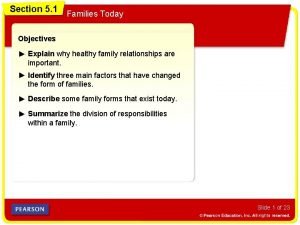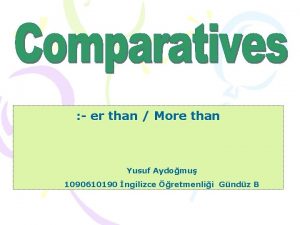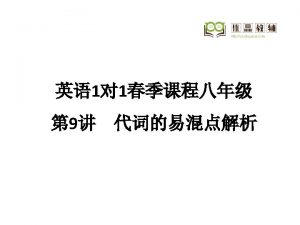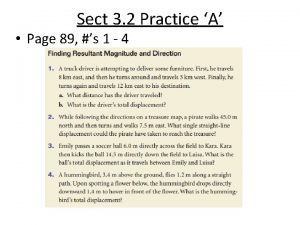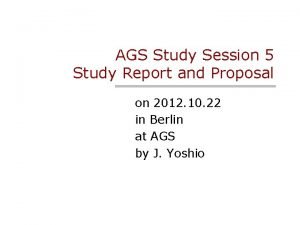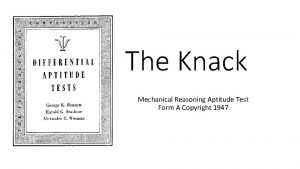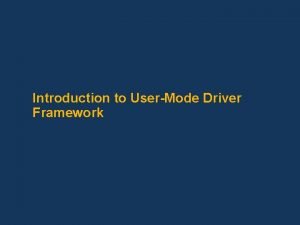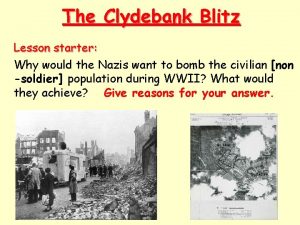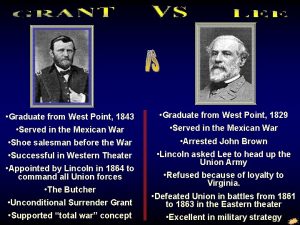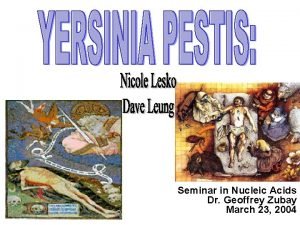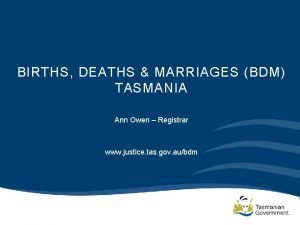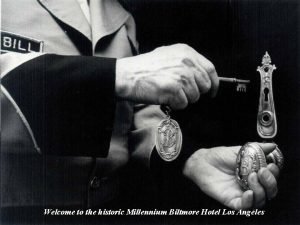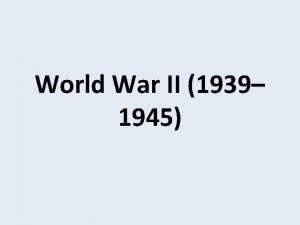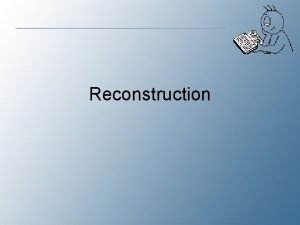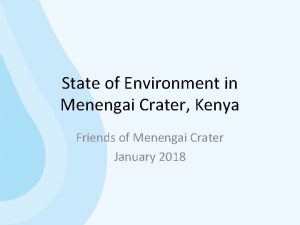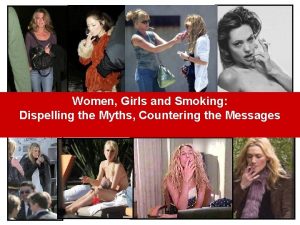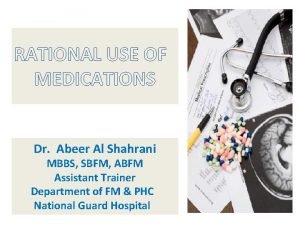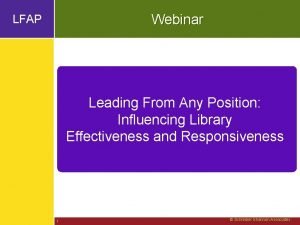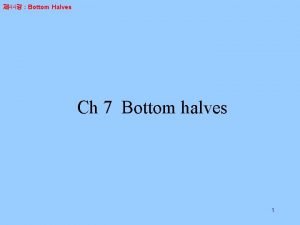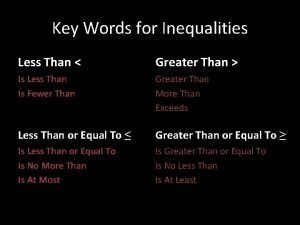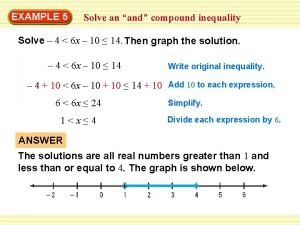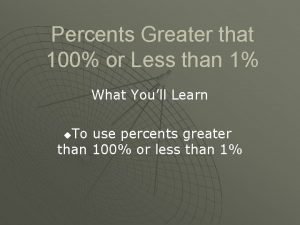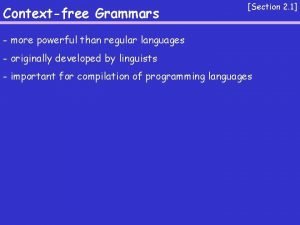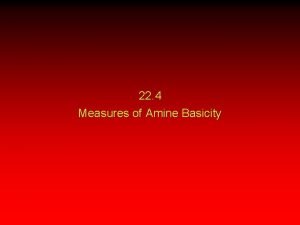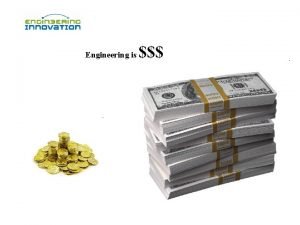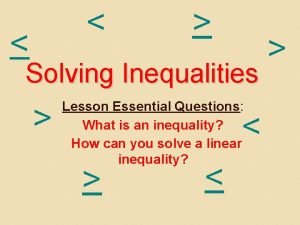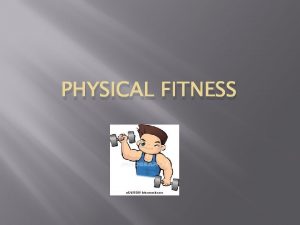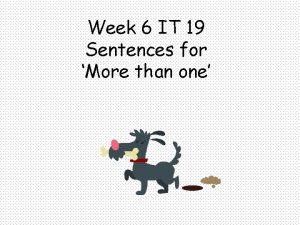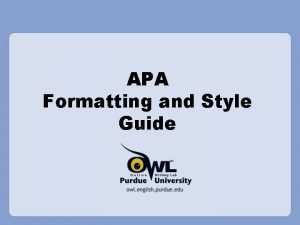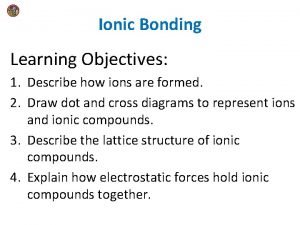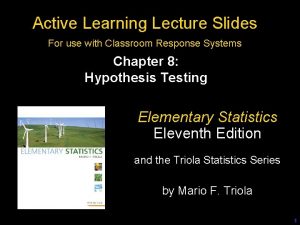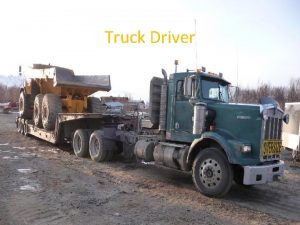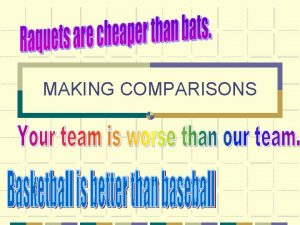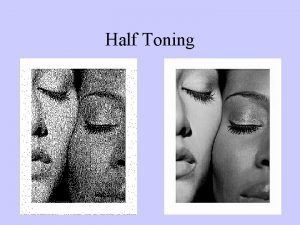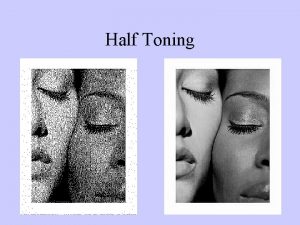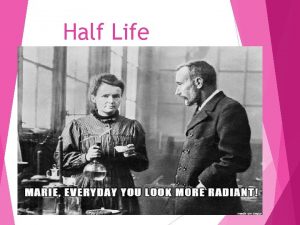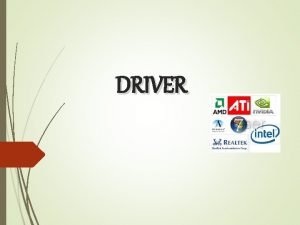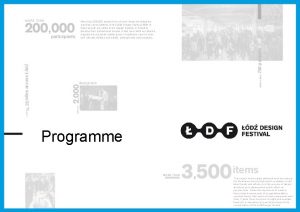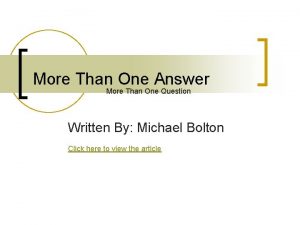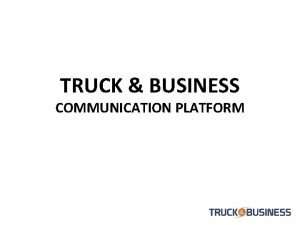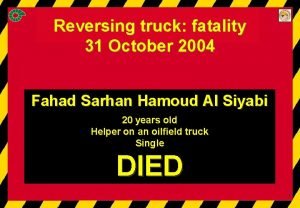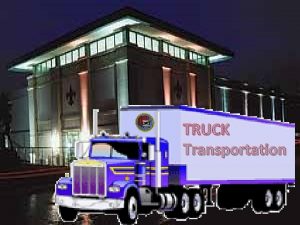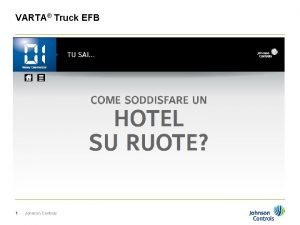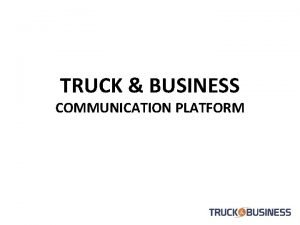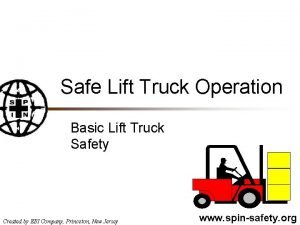More than half of truck driver deaths in































































- Slides: 63


More than half of truck driver deaths in crashes are the result of truck rollovers. When more cargo is piled up in a truck, the "center of gravity" moves higher up from the road. The truck becomes easier to turn over. Fully loaded rigs are ten times more likely to roll over in a crash than empty rigs. {

Two things will help you prevent roll-over Keep the cargo as close to the ground as possible, and drive slowly around turns. Keeping cargo low is even more important in combination vehicles than in straight trucks. Keep the load centered on your rig. If the load is to one side so it makes a trailer lean, a rollover is more likely. Make sure your cargo is centered and spread out as much as possible. Right or Wrong?

STEER GENTLY Trucks with trailers have a dangerous "crack-the-whip" effect. When you make a quick lane change, the crack-the-whip effect can turn the trailer over. Steer gently and smoothly when you are pulling trailers. If you make a sudden movement with your steering wheel, your trailer could tip over. Look far enough down the road to avoid being surprised and having to make a sudden lane change. At night, drive slowly enough to see obstacles with your headlights before it is too late to change lanes or stop gently. Slow down to a safe speed before going into a turn.

BRAKE EARLY Control your speed whether fully loaded or empty. Large combination vehicles take longer to stop when they are empty than when they are fully loaded. Your trailer can swing out and strike other vehicles. Your tractor can jackknife very quickly. Bobtails can be very hard to stop smoothly. It takes them longer to stop than a tractor-semi trailer loaded to maximum gross weight.

RAILROAD-HIGHWAY CROSSINGS Railroad-highway crossings can also cause problems, particularly when pulling trailers with low underneath clearance. These trailers can get stuck on raised crossings: • Low slung units (lowboy, carrier, moving van, possum-belly livestock trailer). • Single-axle tractor pulling a long trailer with its landing gear set to accommodate a tandem-axle tractor.

If for any reason you get stuck on the tracks, get out of the vehicle and away from the tracks. Check signposts or signal housing at the crossing for emergency notification information. Call 911 or other emergency number. Give the location of the crossing using all identifiable landmarks, especially the DOT number, if posted.

PREVENT TRAILER SKIDS When the wheels of a trailer lock up, the trailer will tend to swing around. This is more likely to happen when the trailer is empty or lightly loaded. Recognize the Skid. The earliest and best way to recognize that the trailer has started to skid is by seeing it in your mirrors. Any time you apply the brakes hard; check the mirrors to make sure the trailer is staying where it should be. Once the trailer swings out of your lane, it is very difficult to prevent a jackknife

TURNS When a vehicle goes around a corner, the rear wheels follow a different path than the front wheels. This is called off tracking. Off tracking causes the path followed by a tractor to be wider than the rig itself. Longer vehicles will off-track more. The rear wheels of the powered unit (truck or tractor) will off-track some, and the rear wheels of the trailer will off-track even more. . Steer the front end wide enough around a corner so the rear end does not run over the curb, pedestrians, etc. However, keep the rear of your vehicle close to the curb. This will stop other drivers from passing you on the right. If you cannot complete your turn without entering another traffic lane, turn wide as you complete the turn. This is better than swinging wide to the left before starting the turn because it will keep other drivers from passing you on the right.

TRAILER HAND VALVE The trailer hand valve (also called the Johnson bar) works the trailer brakes. The trailer and valve should be used only to test the trailer brakes. Do not use it in driving because of the danger of making the trailer skid. Never use the hand valve for parking because all the air might leak out unlocking the brakes (in trailers that don't have spring brakes). Always use the parking brakes when parking. If the trailer does not have spring brakes, use wheel chocks to keep the trailer from moving. {

TRACTOR PROTECTION VALVE The tractor protection valve keeps air in the tractor or truck brake system should the trailer break away or develop a bad leak. The tractor protection valve is controlled by the "trailer air supply" control valve in the cab. The control valve allows you to open and shut the tractor protection valve. The tractor protection valve will close automatically if air pressure is low (in the range of 20 to 45 PSI). When the tractor protection valve closes, it stops any air from going out of the tractor. It also lets the air out of the trailer emergency line. This causes the trailer emergency brakes to come on, with possible loss of control.

TRAILER AIR SUPPLY CONTROL The trailer air supply control on newer vehicles is a red eight-sided knob, which you use to control the tractor protection valve. You push it in to supply the trailer with air, and pull it out to shut the air off and put on the trailer emergency brakes. The valve will pop out (thus closing the tractor protection valve) when the air pressure drops into the range of 20 to 45 PSI.

TRAILER AIR LINES Every combination vehicle has two air lines, the service line and the emergency line. Service Air Line. The service line carries air, which is controlled by the foot brake or the trailer hand brake. Depending on how hard you press the foot brake or hand valve, the pressure in the service line will similarly change. The service line is connected to relay valves. These valves allow the trailer brakes to be applied more quickly than would otherwise be possible. If a major leak develops in the service line and you apply the brakes you should have a low air warning.

Emergency Air Line The emergency line has two purposes. First, it supplies air to the trailer air tanks. Second, the emergency line controls the emergency brakes on combination vehicles. Loss of air pressure in the emergency line causes the trailer emergency brakes to come on. The pressure loss could be caused by a trailer breaking loose, thus tearing apart the emergency air hose. Or it could be caused by a hose, metal tubing, or other part breaking, letting the air out. When the emergency line loses pressure, it also causes the tractor protection valve to close (the air supply knob will pop out).

GLAD HANDS Glad hands are coupling devices used to connect the service and emergency air lines from the truck or tractor to the trailer. The couplers have a rubber seal, which prevents air from escaping. Clean the couplers and rubber seals before a connection is made. When connecting the glad hands, press the two seals together with the couplers at a 90 -degree angle to each other. A turn of the glad hand attached to the hose will join and lock the couplers. When coupling, make sure to couple the proper glad hands together. To help avoid mistakes, colors are used. Blue is used for the service lines and red for the emergency lines. Sometimes, the words "service" and "emergency" or the letters S and E are stamped on them.

If you do cross the air lines, supply air will be sent to the service line instead of going to charge the trailer air tanks. Air will not be available to release the trailer spring brakes (parking brakes). If the spring brakes don't release when you push the trailer air supply control, check the air line connections. CAUTION!!!!! Older trailers (before 1975) do not have spring brakes. If the air supply in the trailer air tank has leaked away there will be no emergency brakes, and the trailer wheels will turn freely. If you crossed the air lines, you could drive away but you wouldn't have trailer brakes. This would be very dangerous. Always test the trailer brakes before driving with the hand valve or by pulling the air supply (tractor protection valve) control. Pull gently against them in a low gear to make sure the brakes work.

Dummy couplers are placed on the rear of the tractor cab to which the hoses may be attached when they are not in use. This will prevent water and dirt from getting into the coupler and the air lines. Use the dummy couplers when the air lines are not connected to a trailer. If there are no dummy couplers, the glad hands can sometimes be locked together (depending on the couplings). It is very important to keep the air supply clean.

How should you test the tractortrailer connection? 1. 2. 3. Use the hand valve and pull against it in a low gear. Set the spring brakes and then visually check the glad hand connections. Set the tractor protection to normal and try the service brakes.

You should use the hand valve to park a combination vehicle: 1. 2. 3. Only when necessary Never Always

Under normal conditions, you should use the hand valve: 1. 2. 3. To prevent skids when applying the service brakes downhill. Never Only to keep the combination in a straight line while braking.

Two things a driver can do to prevent roll-overs involve keeping a low center of gravity and: 1. 2. 3. Making sure the brakes are in adjustment. Going slowly around turns. Downshifting only when necessary.

Which of these statements are true? 1. 2. 3. Light vehicles require more braking power to stop than heavier ones. Heavy vehicles require more stopping distance than empty ones. Bobtail tractors require more stopping distance than fully loaded vehicles.

The hand valve may be used: 1. 2. 3. To correct a trailer skid. To prevent a jackknife To test the trailer brakes.

You should not back a tractor under a trailer until the air system is: 1. 2. 3. At Normal pressure. At least half of normal pressure. Between 90 and 100 psi.

If the service line separates while you are driving, what will happen? 1. 2. 3. The tractor spring brakes will apply. The trailer spring brakes will engage. Nothing, until you step on the foot valve.

You can supply air to the trailer air tanks by: 1. 2. 3. Pushing in the trailer air supply valve. Pulling out on the trailer supply valve. Pushing in the trailer air supply hand valve.

The air lines on a combination vehicle are often color-coded. The emergency line is _____ and the service line is _____. 1. 2. 3. Red, Blue, Red, Yellow

Trailers made before 1975: 1. 2. 3. Usually require glad hand converters. Are usually heavier. Often do not have spring brakes.

You are coupling a trailer to your tractor, but are not under it yet. What should you connect before continuing? 1. 2. 3. The electrical cable. The emergency and service lines. Nothing. Just back up and couple.

A driver crossed the air lines when coupling to a trailer without spring brakes. The results would be: 1. 2. 3. He might be able to drive away, but would have no service brakes. He could not drive away. He could drive away, but would have not emergency brakes.

The air line glad hands should be attached to the dummy couplers: 1. 2. 3. To prevent air leakage. To keep out dirt and moisture. To build air pressure.

The safety catch for t he 5 th wheel muxt be _____ the locking lever. 1. 2. 3. Under Over Through

Your emergency line develops a severe leak while you are driving. The loss of pressure will: 1. 2. 3. Cause the tractor protection valve to close Cause the low air pressure waning system to activate. Cause both of the above to occur.

You have a major leak in the service line and you put on the brakes. You should first expect: 1. 2. 3. The tractor spring brakes to apply. A low air pressure warning. The trailer spring brakes to be inoperative.

It is not hard to do… but… there is no margin for error! {

Inspect Fifth Wheel • Check for damaged/missing parts. • Check to see that mounting to tractor is secure, no cracks in frame, etc. • Be sure that the fifth wheel plate is greased as required. Failure to keep the fifth wheel plate lubricated could cause steering problems because of friction between the tractor and trailer. • Check if fifth wheel is in proper position for coupling: . . Wheel tilted down toward rear of tractor. . . Jaws open. . . Safety unlocking handle in the automatic lock position. . . If you have a sliding fifth wheel, make sure it is locked. . . Make sure the trailer kingpin is not bent or broken.

Inspect Area and Chock Wheels • Make sure area around the vehicle is clear. • Be sure trailer wheels are chocked or spring brakes are on. • Check that cargo (if any) is secured against movement due to tractor being coupled to the trailer. Position tractor directly in front of trailer. Approach with the trailer on your left and begin turning out just as the tractor’s front bumper approaches the corner of the trailer. Use both mirrors to line up with the trailer. Try to get an even amount of trailer to show in each mirror. Remember the bobtail tractor will back just like a car.

Back slowly until you are approximately one quarter of the way under the Fifth Wheel and no more than halfway under. Being able to tell where this point is may take some practice. It is better to stop too soon than too late, though! Backing under a trailer when the trailer is too high can lead to a “High Hook. ” • Secure Tractor • Put on the parking brake. • Put transmission in neutral.

Check Trailer Height • The trailer should be low enough that it is raised slightly by the tractor when the tractor is backed under it. Raise or lower the trailer as needed. (If the trailer is too low, the tractor may strike and damage the trailer nose; if the trailer is too high, it may not couple correctly. ) • Check that the kingpin and fifth wheel are aligned. Connect Air Lines to Trailer • Check glad hand seals and connect tractor emergency air line to trailer emergency glad hand. • Check glad hand seals and connect tractor service air line to trailer service glad hand. • Make sure air lines are safely supported where they won't be crushed or caught while tractor is backing under the trailer.

Supply Air to Trailer • From cab, push in "air supply" knob to supply air to the trailer brake system. • Wait until the air pressure is normal. • Check brake system for crossed air lines: . . Shut engine off so you can hear the brakes. . . Apply and release trailer brakes and listen for sound of trailer brakes being applied and released. You should hear the brakes move when applied and air escape when the brakes are released. . . Check air brake system pressure gauge for signs of major air loss: For a combination vehicle with the engine off and the service brakes applied the leakage rate should be no more than 4 psi in a minute. With the engine off and the service brakes released the leakage rate Should be no more than 3 psi in a minute. • When you are sure trailer brakes are working, start engine. • Make sure air pressure is up to normal.

Lock Trailer Brakes Pull out the "air supply" knob or move the tractor protection valve control from "normal" to "emergency". Backing Under Trailer • Use lowest reverse gear. • Back tractor slowly under trailer to avoid hitting the kingpin too hard. • Stop when the kingpin is locked into the fifth wheel. Check Connection for Security • Pull tractor gently forward while the trailer brakes are still locked to check that the trailer is locked onto the tractor.

Secure Vehicle • Put transmission in neutral. • Put parking brakes on. • Shut off engine and take key with you so someone else won't move truck while you are under it. Inspect Coupling • Use a flashlight, if necessary. • Make sure there is no space between upper and lower fifth wheel. If there is space, something is wrong (kingpin may be on top of the closed fifth wheel jaws, and trailer would come loose very easily).


• Go under trailer and look into the back of the fifth wheel. Make sure the fifth wheel jaws have closed around the shank of the kingpin. • Check that the locking lever is in the "lock" position. • Check that the safety latch is in position over locking lever. (On some fifth wheels the catch must be put in place by hand. ) • If the coupling isn't right, don't drive the coupled unit; get it fixed.

Connect the Electrical Cord and Check Air Lines • Plug the electrical cord into the trailer and fasten the safety catch. • Check both air lines and electrical line for signs of damage. • Make sure air and electrical lines will not hit any moving parts of vehicle.

Raise Landing Gear • Use low gear range (if so equipped) to begin raising the landing gear. Once free of weight, switch to the high gear range. • Raise the landing gear all the way up. (Never drive with landing gear only part way up as it may catch on railroad tracks or other things. ) • After raising landing gear, secure the crank handle safely. • When full weight of trailer is resting on tractor: Check for enough clearance between rear of tractor frame and landing gear. (When tractor turns sharply, it must not hit landing gear. ) Check that there is enough clearance between the top of the tractor tires and the nose of the trailer.

UNCOUPLING • Make surface of parking area can support weight of trailer. • Have tractor lined up with the trailer. (Pulling out at an angle can damage landing gear. ) Ease Pressure on Locking Jaws • Shut off trailer air supply to lock trailer brakes. • Ease pressure on fifth wheel locking jaws by backing up gently. (This will help you release the fifth wheel locking lever. ) • Put parking brakes on while tractor is pushing against the kingpin. (This will hold rig with pressure off the locking jaws. )

Chock Trailer Wheels • Chock the trailer wheels if the trailer doesn't have spring brakes or if you're not sure. (The air could leak out of the trailer air tank, releasing its emergency brakes. Without chocks the trailer could move. ) Lower the Landing Gear • If trailer is empty, lower the landing gear until it makes firm contact with the ground. • If trailer is loaded, after the landing gear makes firm contact with the ground, turn crank in low gear a few extra turns. This will lift some weight off the tractor. (Do not lift trailer off the fifth wheel. ) This will: . . Make it easier to unlatch fifth wheel. . . Make it easier to couple next time.

Disconnect Air Lines and Electrical Cable • Disconnect air lines from trailer. Connect air line glad hands to dummy couplers at back of cab or couple them together. • Hang electrical cable with plug down to prevent moisture from entering it. • Make sure lines are supported so they won't be damaged while driving the tractor. Unlock Fifth Wheel • Raise the release handle lock. • Pull the release handle to "open" position. • Keep legs and feet clear of the rear tractor wheels to avoid serious injury in case the vehicle moves.

Pull Tractor Partially Clear of Trailer • Pull tractor forward until fifth wheel comes out from under the trailer. • Stop with tractor frame under trailer (prevents trailer from falling to ground if landing gear should collapse or sink). Inspect Landing Gear • Make sure ground is supporting trailer. • Make sure landing gear is not damaged. Pull Tractor Clear of Trailer • Release parking brakes. • Check the area and drive tractor forward until it clears.

Before you under back under a trailer, make sure that: 1. 2. 3. The tractor will not move. The tractor protection valve is normal. The air brakes are on.

You are coupling a trailer to your tractor. The trailer is at the correct height when: 1. 2. 3. The end of the king pin is even with the 5 th wheel. The king pin is aligned with the 5 th wheel. The trailer will raise slightly when you back under it.

When you back under a trailer, you should line up: 1. 2. 3. The king pin with the 5 th wheel. Directly in front of the trailer.

The locking jaws of the 5 th wheel could lock around the king pin: 1. 2. 3. Head. Base. Shank.

The 5 th wheel is not locked after the jaws close. This means: 1. 2. 3. It can be adjusted for weight distribution. The 5 th wheel may be moved if necessary. The coupling is not correct and should be fixed.

The air leakage rate for a combination vehicle with the engine off and the service brake applied should be no more than: 1. 2. 3. 3 PSI. 2 PSI. 4 PSI.

You have coupled with a trailer. In what position should the landing gear be before driving away? 1. 2. 3. Fully down with the handle stored. Fully raised with the handle in the bracket. Fully raised with the handle free.

The air leakage rate for a combination vehicle with the engine off and the service brakes released should be less than: 1. 2. 3. 3 PSI. 2 PSI. 4 PSI.

The 5 th wheel should be well lubricated to insure: 1. 2. 3. A proper connection to the trailer apron. The lack of steering problems. The reduction of noise.

After you supply air to the trailer, make sure the air lines are not crossed and the trailer brakes are working by: 1. 2. 3. Stepping on the brake pedal while pulling away. Use the hand valve while pulling. Visually inspect the glad hand connections the service brake adjustment.

You are coupling a tractor to your trailer. Before backing under the trailer, you should: 1. 2. 3. Make sure the trailer will not move. Make sure that the trailer service brakes are off. Make sure that the trailer has emergency brakes.

You have coupled your tractor to a trailer. Make sure that: 1. 2. 3. You have enough clearance between the trailer apron and the tractor tires. You have enough clearance between the tractor frame and landing gear. You have both of the above.

You have coupled to a trailer. How much space should be between the 5 th wheel and the trailer? 1. 2. 3. None. ½ inch. No more than 1/16 inch.
 More more more i want more more more more we praise you
More more more i want more more more more we praise you Lirik lagu more more more we praise you
Lirik lagu more more more we praise you Half life more than 2 less than 4
Half life more than 2 less than 4 5-1 changing households
5-1 changing households Most millionaires attended private schools
Most millionaires attended private schools Generous kelimesinin comparative hali
Generous kelimesinin comparative hali Better than god
Better than god A truck driver attempting to deliver some furniture
A truck driver attempting to deliver some furniture A truck driver is attempting to deliver some furniture
A truck driver is attempting to deliver some furniture Jnpt truck and driver registration
Jnpt truck and driver registration Jnpt truck and driver registration
Jnpt truck and driver registration Mechanical reasoning exam
Mechanical reasoning exam Windows driver foundation - user-mode driver framework
Windows driver foundation - user-mode driver framework Clydebank blitz deaths
Clydebank blitz deaths Bulimia face
Bulimia face West point graduate deaths
West point graduate deaths Tobacco causes _______ of cancer deaths around the world. *
Tobacco causes _______ of cancer deaths around the world. * World million deaths
World million deaths Births deaths marriages tas
Births deaths marriages tas Ava fontaine
Ava fontaine Siapa pemenang perang dunia 2
Siapa pemenang perang dunia 2 Deaths in civil war
Deaths in civil war Menengai crater deaths
Menengai crater deaths Camel no 9
Camel no 9 Heart of darkness deaths
Heart of darkness deaths Heart of darkness deaths
Heart of darkness deaths 2020 motor vehicle deaths
2020 motor vehicle deaths Dr abeer deaths
Dr abeer deaths Gerard wijtsma
Gerard wijtsma Mythological creature half man half horse
Mythological creature half man half horse Half man half horse name
Half man half horse name Half empty or half full
Half empty or half full Scar the joy luck club
Scar the joy luck club Half man half horse name
Half man half horse name Two circumferential clasps joined at the body
Two circumferential clasps joined at the body Gerald croft
Gerald croft Classification of direct retainers
Classification of direct retainers Half woman half snake greek mythology
Half woman half snake greek mythology Top half vs bottom half
Top half vs bottom half Delphi
Delphi Jesus lord of heaven
Jesus lord of heaven Greater than less than fractions
Greater than less than fractions Keywords for inequalities
Keywords for inequalities Numberblock 1 and 2
Numberblock 1 and 2 Greater than less than fractions
Greater than less than fractions Greater than less than examples
Greater than less than examples Percent greater than 100 and less than 1
Percent greater than 100 and less than 1 Will it take more than open
Will it take more than open Marketing manager
Marketing manager Can more things be dissolved in sulfuric acid than water
Can more things be dissolved in sulfuric acid than water Cfgs are more powerful than
Cfgs are more powerful than Basicity of arylamines
Basicity of arylamines A dollar today is worth more than a dollar tomorrow
A dollar today is worth more than a dollar tomorrow Open and closed circle
Open and closed circle R v millard and vernon
R v millard and vernon Long term fitness goals
Long term fitness goals Sentence about climb
Sentence about climb How to cite in text apa with more than one author
How to cite in text apa with more than one author Jaguar poem summary
Jaguar poem summary Every year more than eleven million
Every year more than eleven million More protons than electrons
More protons than electrons Why does new guinea have more species of birds than bali?
Why does new guinea have more species of birds than bali? Parallelism definition
Parallelism definition A medical school claims that more than 28
A medical school claims that more than 28



